Mexico Helps Migrant Caravan Headed to U.S. Border
Migrant caravans often disperse during their trek through Mexico, but many of their members still end up at the border.

The largest migrant caravan to date this year has mostly dissipated, but that doesn’t mean that thousands more migrants are no longer headed to the U.S.-Mexico border.
Members of the migrant caravan initially gathered in the city of Tapachula on the Mexican side of the Mexico-Guatemala border, and set off on their march towards the United States in the second week of June. While the caravan formed in and departed from a Mexican town, the bulk of the caravan’s members were from Venezuela, Cuba, and Nicaragua. There were also Haitians, Salvadorans, Hondurans, and Guatemalans in the mix. Individuals from India, Bangladesh, and some African countries were also spotted in the caravan’s ranks.
The caravan topped out at around 11,000 members. The organizer of the caravan, Luís Villagrán of the Center for Human Dignification, claimed that nearly 70 percent of the caravan’s members were women and children, from newborns to elderly individuals in their seventies. But a quick Google search for images of the caravan before it dispersed seems to suggest that the composition of the caravan was not, in fact, 70 percent women and children. If the scores of photos of the caravan are representative of the whole, men—particularly younger, working-age men—made up more than 30 percent of the caravan’s members.
It's no surprise that Villagrán might lie about the composition of his caravan, or at least feign ignorance and embellish the truth. Previously, Villagrán organized other caravans during the Trump administration’s tenure, as well as several others last year, though those caravans also dispersed on the trek north.
What is surprising, however, is Villagrán's candor about the fact that these caravans are nothing more than a political stunt. “Immigration is used as a political tool. These women and children are like coins to be exchanged,” Villagrán told the Guardian.
Prior to the caravan’s departure, the Mexican National Migration Institute (INM), while not typically helpful towards such caravans, wrote a letter to Villagrán expressing sympathy for migrants and promising to protect them. “It’s very possible [Mexican President Andrés Manuel López] Obrador wants to use this caravan to look like a humanitarian before the Summit of the Americas,” the letter read, which is partly why Villagrán scheduled the caravan’s departure to line up with the summit.
Villagrán clearly doesn’t feel ashamed. But he should. Though there might be truth in the old saying “there’s safety in the herd,” joining these massive caravans still involves serious risk. As word spreads that these caravans are passing through certain Mexican communities, it attracts the worst of humanity. Migrants risk becoming victims of sexual assault or rape, or falling prey to human smugglers, coyotes, and cartels, not to mention the possibility of injury, disease, or death due to the physical toll of the journey.
After traveling fewer than 25 miles over the course of about a week, the INM announced that Mexican authorities granted members of the caravan documentation providing these individuals legal status in Mexico as they make their way to the U.S.
Mexican law prevents migrants from traveling beyond Mexico’s southern state of Chiapas without this documentation, a provision put in place during the Trump-era migrant crisis from 2018 to 2019. Though the caravan was not close to leaving Chiapas—again, it only traveled about 25 miles—Mexican authorities decided to grant the caravan members legal status anyways. It is estimated that upwards of 9,000 individuals have received the legal status needed to continue north.
The INM said the documentation means “migrants are prevented from being victims of criminals who are dedicated to human trafficking or traffickers who expose the migrants to unsafe conditions."
Typically, migrants attempting to get to the U.S. do not seek or request protection from the Mexican government out of fear of being turned away by INM personnel at the border, or being deported to their home countries if they approach the INM after making their way further into Mexico. But the INM’s open communication with the caravan, as well as its quick approval of legal status for America-bound migrants, could be a concerning sign of what is to come.
Subscribe Today
Get daily emails in your inbox
Make no mistake: The left wants to break America’s immigration system to make mass amnesty the only apparent solution to our migration problem, and gain millions of voters in the process. Bad actors like Villagrán do their bidding on the ground, and institutions like the INM play right into their hands. Their attempt to make one crisis go away quietly will only create more crises down the line. If this new precedent set by the INM becomes the norm, the result will be a vicious cycle of higher and higher levels of migration until someone with the political will comes along and says "Enough."
It may be true that providing this documentation discourages some of the current migrants from seeking extreme measures to get to the U.S.-Mexico border, where they still may attempt to buy or smuggle their way across even with their legal Mexican status. A protracted stay in Mexico is not these migrants' goal, even if Mexico would qualify as a first safe country for individuals claiming to be asylum seekers or refugees.
Nevertheless, providing this documentation only incentivizes further migration, as evidenced by the massive influx of migrants to the U.S. southern border over the course of President Joe Biden’s tenure after his promises to liberalize U.S. immigration laws. The members of the latest migrant caravan are scattered in the wind for now, but soon they’ll once again amass at the U.S.-Mexico border, where those waiting to gain entry into the United States reportedly number in the hundreds of thousands.
Comments